MBS662 Report: Business, Society, and Environment Unit Reflection
VerifiedAdded on 2022/11/25
|11
|2666
|463
Report
AI Summary
This report delves into the interconnectedness of business, society, and the environment, concentrating on shared value creation and innovation strategies. It explores the significance of innovation for organizational success, emphasizing the need for new ideas and strategies to adapt to dynamic market conditions. The report also analyzes supply chain management, highlighting the importance of value alignment and ethical considerations. It examines how an understanding of these topics can inform decision-making in business, government, and civil society organizations, emphasizing the benefits of shared value creation and ethical practices. The report discusses the importance of small wins and the role of ethics in personal action, concluding that business must embrace innovation and ethical practices to foster a sustainable and responsible approach to business operations.
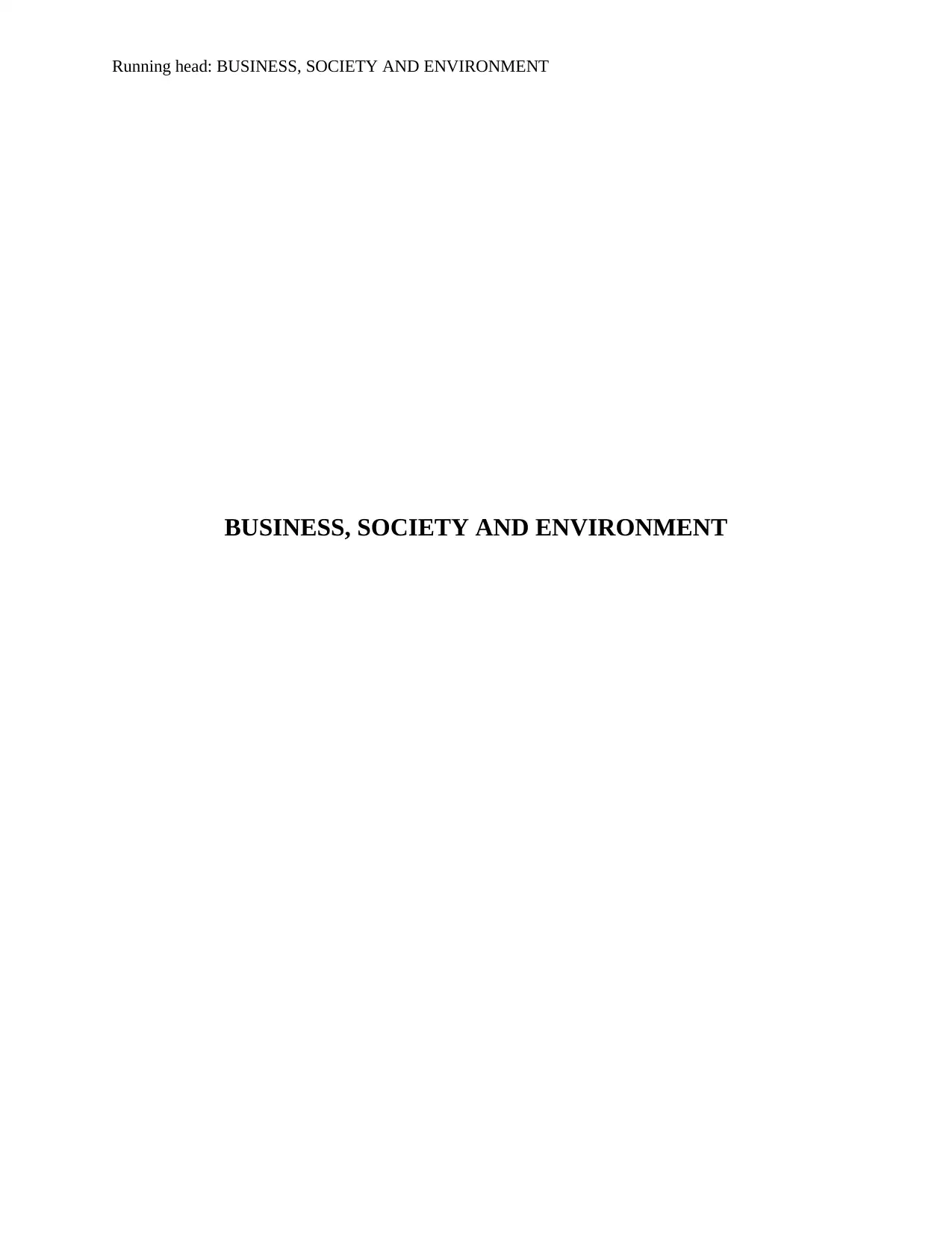
Running head: BUSINESS, SOCIETY AND ENVIRONMENT
BUSINESS, SOCIETY AND ENVIRONMENT
BUSINESS, SOCIETY AND ENVIRONMENT
Paraphrase This Document
Need a fresh take? Get an instant paraphrase of this document with our AI Paraphraser
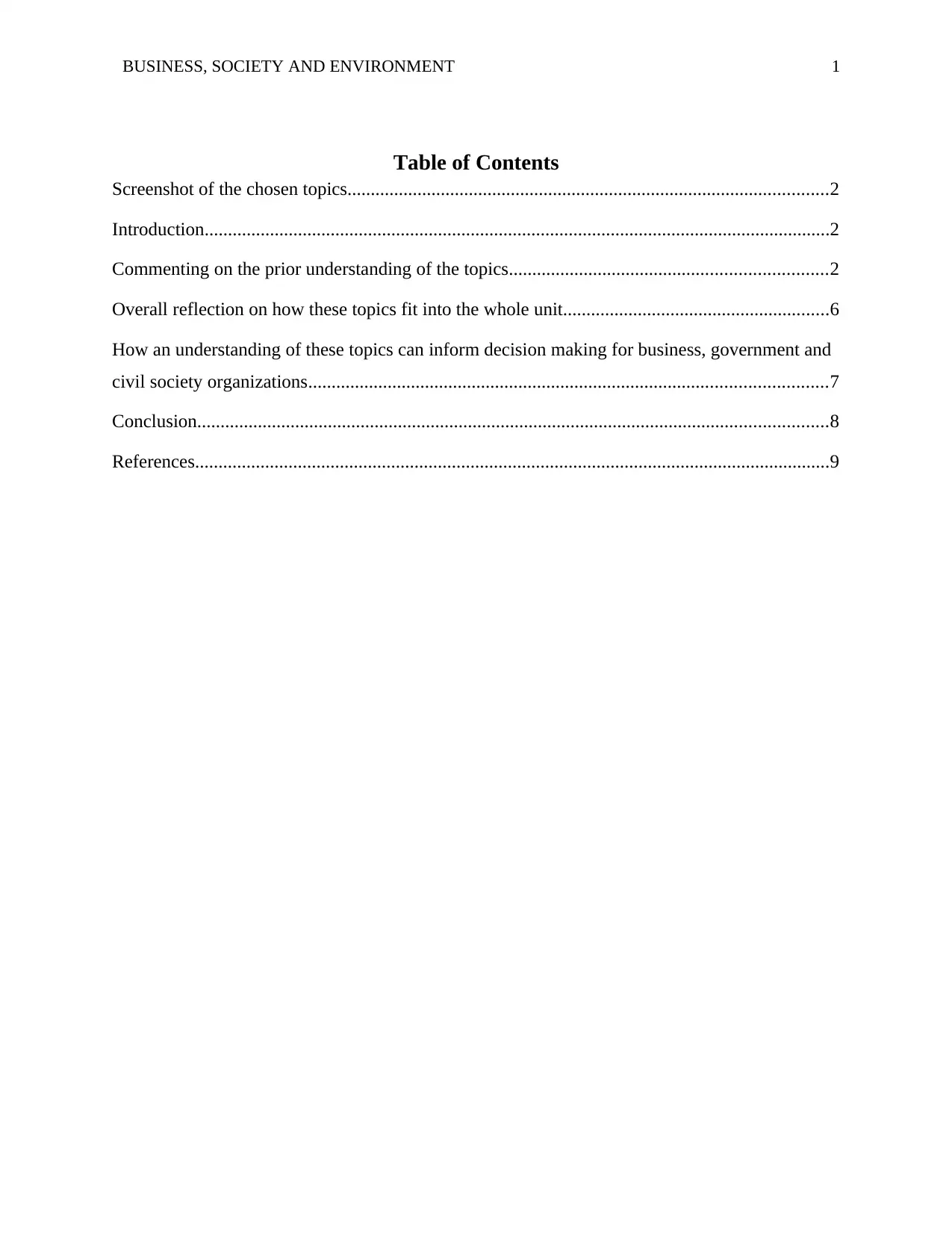
BUSINESS, SOCIETY AND ENVIRONMENT 1
Table of Contents
Screenshot of the chosen topics.......................................................................................................2
Introduction......................................................................................................................................2
Commenting on the prior understanding of the topics....................................................................2
Overall reflection on how these topics fit into the whole unit.........................................................6
How an understanding of these topics can inform decision making for business, government and
civil society organizations...............................................................................................................7
Conclusion.......................................................................................................................................8
References........................................................................................................................................9
Table of Contents
Screenshot of the chosen topics.......................................................................................................2
Introduction......................................................................................................................................2
Commenting on the prior understanding of the topics....................................................................2
Overall reflection on how these topics fit into the whole unit.........................................................6
How an understanding of these topics can inform decision making for business, government and
civil society organizations...............................................................................................................7
Conclusion.......................................................................................................................................8
References........................................................................................................................................9
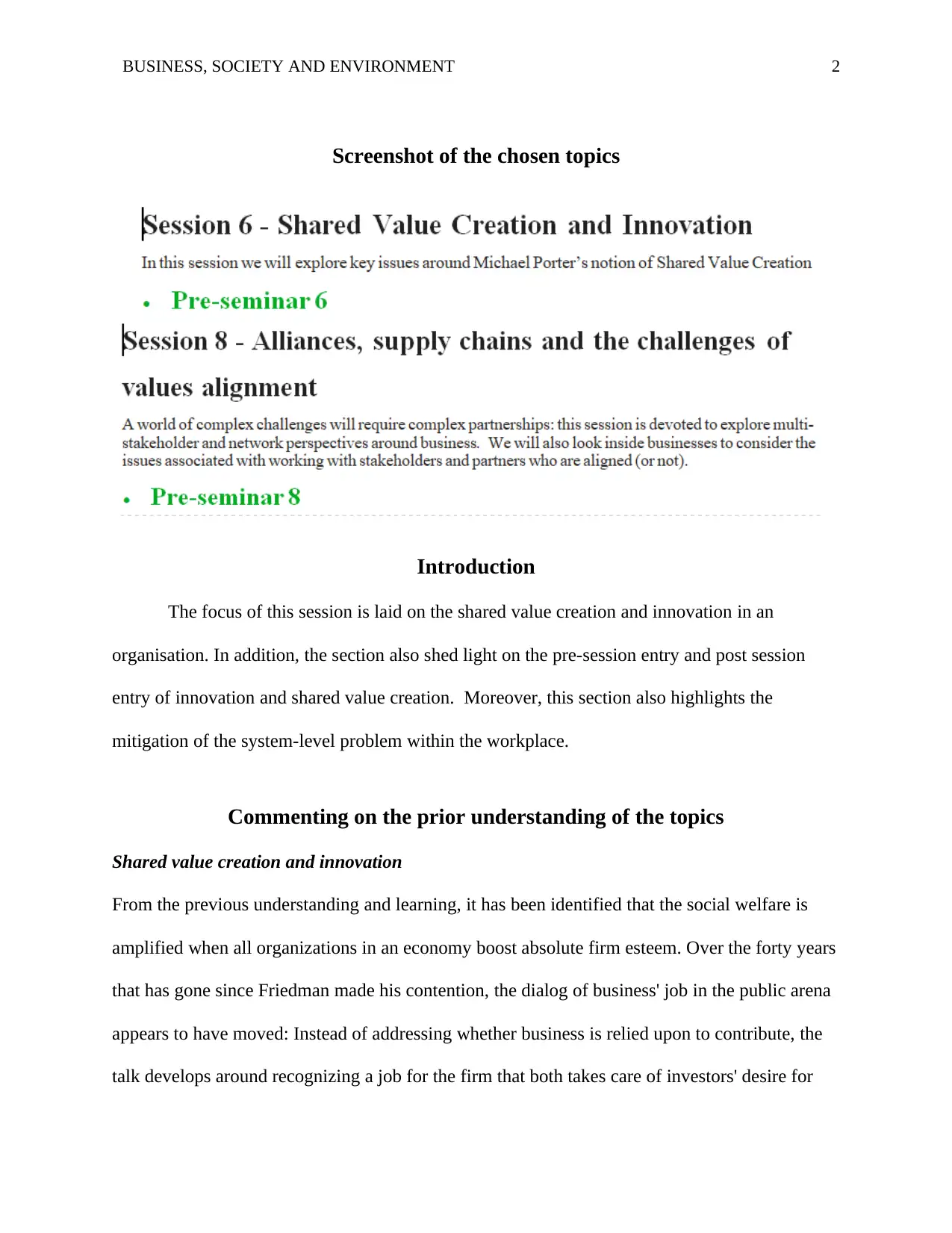
BUSINESS, SOCIETY AND ENVIRONMENT 2
Screenshot of the chosen topics
Introduction
The focus of this session is laid on the shared value creation and innovation in an
organisation. In addition, the section also shed light on the pre-session entry and post session
entry of innovation and shared value creation. Moreover, this section also highlights the
mitigation of the system-level problem within the workplace.
Commenting on the prior understanding of the topics
Shared value creation and innovation
From the previous understanding and learning, it has been identified that the social welfare is
amplified when all organizations in an economy boost absolute firm esteem. Over the forty years
that has gone since Friedman made his contention, the dialog of business' job in the public arena
appears to have moved: Instead of addressing whether business is relied upon to contribute, the
talk develops around recognizing a job for the firm that both takes care of investors' desire for
Screenshot of the chosen topics
Introduction
The focus of this session is laid on the shared value creation and innovation in an
organisation. In addition, the section also shed light on the pre-session entry and post session
entry of innovation and shared value creation. Moreover, this section also highlights the
mitigation of the system-level problem within the workplace.
Commenting on the prior understanding of the topics
Shared value creation and innovation
From the previous understanding and learning, it has been identified that the social welfare is
amplified when all organizations in an economy boost absolute firm esteem. Over the forty years
that has gone since Friedman made his contention, the dialog of business' job in the public arena
appears to have moved: Instead of addressing whether business is relied upon to contribute, the
talk develops around recognizing a job for the firm that both takes care of investors' desire for
⊘ This is a preview!⊘
Do you want full access?
Subscribe today to unlock all pages.

Trusted by 1+ million students worldwide
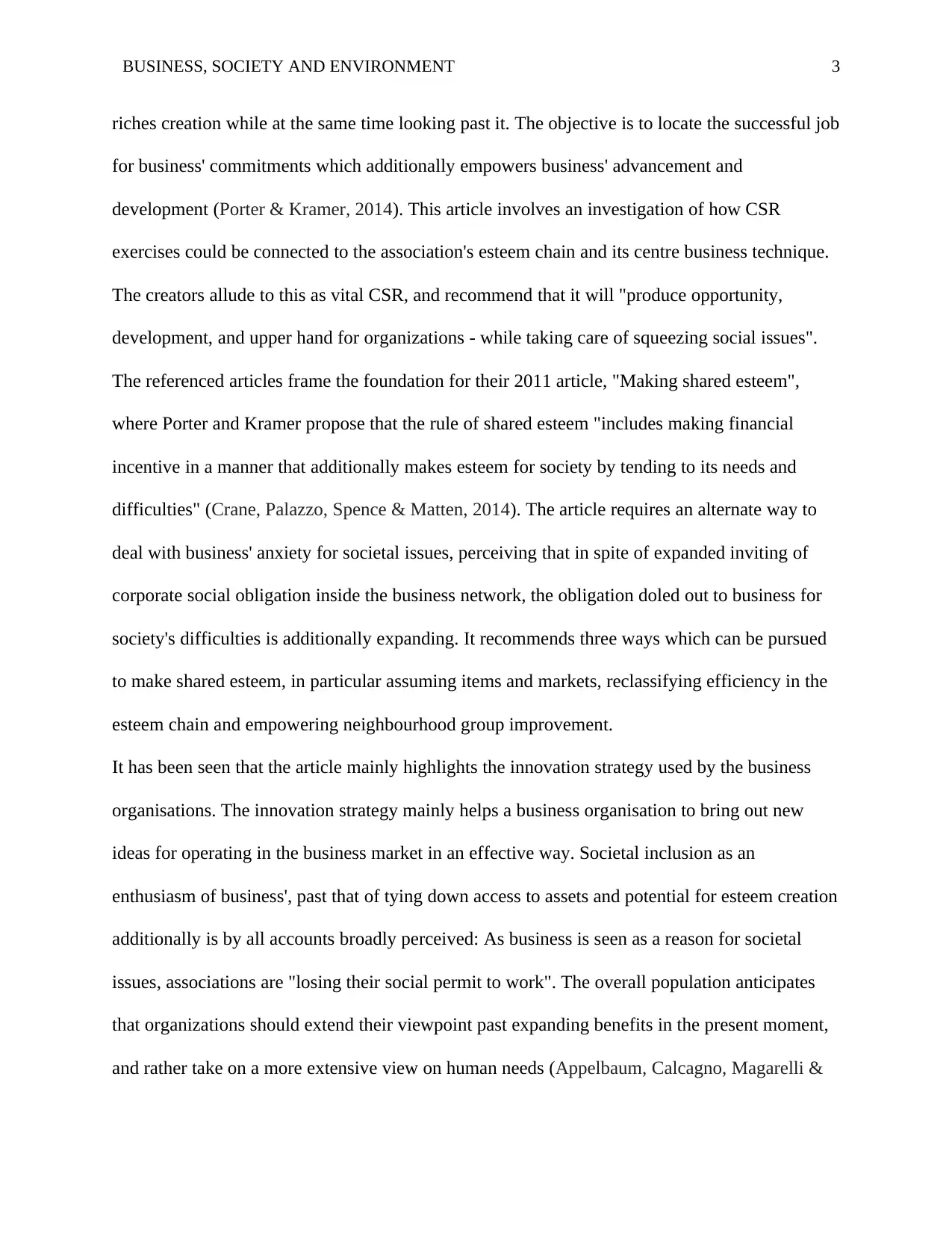
BUSINESS, SOCIETY AND ENVIRONMENT 3
riches creation while at the same time looking past it. The objective is to locate the successful job
for business' commitments which additionally empowers business' advancement and
development (Porter & Kramer, 2014). This article involves an investigation of how CSR
exercises could be connected to the association's esteem chain and its centre business technique.
The creators allude to this as vital CSR, and recommend that it will "produce opportunity,
development, and upper hand for organizations - while taking care of squeezing social issues".
The referenced articles frame the foundation for their 2011 article, "Making shared esteem",
where Porter and Kramer propose that the rule of shared esteem "includes making financial
incentive in a manner that additionally makes esteem for society by tending to its needs and
difficulties" (Crane, Palazzo, Spence & Matten, 2014). The article requires an alternate way to
deal with business' anxiety for societal issues, perceiving that in spite of expanded inviting of
corporate social obligation inside the business network, the obligation doled out to business for
society's difficulties is additionally expanding. It recommends three ways which can be pursued
to make shared esteem, in particular assuming items and markets, reclassifying efficiency in the
esteem chain and empowering neighbourhood group improvement.
It has been seen that the article mainly highlights the innovation strategy used by the business
organisations. The innovation strategy mainly helps a business organisation to bring out new
ideas for operating in the business market in an effective way. Societal inclusion as an
enthusiasm of business', past that of tying down access to assets and potential for esteem creation
additionally is by all accounts broadly perceived: As business is seen as a reason for societal
issues, associations are "losing their social permit to work". The overall population anticipates
that organizations should extend their viewpoint past expanding benefits in the present moment,
and rather take on a more extensive view on human needs (Appelbaum, Calcagno, Magarelli &
riches creation while at the same time looking past it. The objective is to locate the successful job
for business' commitments which additionally empowers business' advancement and
development (Porter & Kramer, 2014). This article involves an investigation of how CSR
exercises could be connected to the association's esteem chain and its centre business technique.
The creators allude to this as vital CSR, and recommend that it will "produce opportunity,
development, and upper hand for organizations - while taking care of squeezing social issues".
The referenced articles frame the foundation for their 2011 article, "Making shared esteem",
where Porter and Kramer propose that the rule of shared esteem "includes making financial
incentive in a manner that additionally makes esteem for society by tending to its needs and
difficulties" (Crane, Palazzo, Spence & Matten, 2014). The article requires an alternate way to
deal with business' anxiety for societal issues, perceiving that in spite of expanded inviting of
corporate social obligation inside the business network, the obligation doled out to business for
society's difficulties is additionally expanding. It recommends three ways which can be pursued
to make shared esteem, in particular assuming items and markets, reclassifying efficiency in the
esteem chain and empowering neighbourhood group improvement.
It has been seen that the article mainly highlights the innovation strategy used by the business
organisations. The innovation strategy mainly helps a business organisation to bring out new
ideas for operating in the business market in an effective way. Societal inclusion as an
enthusiasm of business', past that of tying down access to assets and potential for esteem creation
additionally is by all accounts broadly perceived: As business is seen as a reason for societal
issues, associations are "losing their social permit to work". The overall population anticipates
that organizations should extend their viewpoint past expanding benefits in the present moment,
and rather take on a more extensive view on human needs (Appelbaum, Calcagno, Magarelli &
Paraphrase This Document
Need a fresh take? Get an instant paraphrase of this document with our AI Paraphraser

BUSINESS, SOCIETY AND ENVIRONMENT 4
Saliba, 2016). Thus, it is by all accounts basic for society, yet additionally for business, that the
dangers and challenges confronting society are tended to mitigate the errors. It is also very
important for the business managers for developing a suitable innovation strategy for developing
the organisational process in an effective way.
Supply chain and challenges of value alignment
From the previous understanding and learning, the supply chain management process will mainly
help the business authorities of an organisation to develop a suitable process for managing the
business organisation. In addition, the supply chain process will also help the customers to
identify their required products from the business firm. Moreover, the market-making
developments make occupations, yet require capital. Instances of market creating developments
incorporate new innovations like the vehicle, the PC, the cell phone and so forth (Alcaraz,
Hollander & Navarra, 2019). These sorts of developments are showcasing making on the
grounds that such a large number of individuals can possess and utilize these PCs or vehicles.
Since more individuals are getting them, organizations need to procure more individuals to cause
them, to disseminate them and to offer them, and to support them. Market Creating Innovations
utilize capital; when an organization develops it needs to put resources on the parity sheet, for
example, industrial facilities and creation hardware. Supporting developments, then again,
verifies employments however don't really make new ones, and does not require a great deal of
capital. Continuing developments are improving vehicles, or better PCs, at the end of the day it is
about steady upgrades to existing advances. The reason for existing is to improve great items.
These sorts of advancements are imperative to the economy as it keeps businesses productive;
however overall they don't make occupations. The reason is the point at which we purchase an
improved item we don't purchase the bygone one. By their very nature, supporting developments
Saliba, 2016). Thus, it is by all accounts basic for society, yet additionally for business, that the
dangers and challenges confronting society are tended to mitigate the errors. It is also very
important for the business managers for developing a suitable innovation strategy for developing
the organisational process in an effective way.
Supply chain and challenges of value alignment
From the previous understanding and learning, the supply chain management process will mainly
help the business authorities of an organisation to develop a suitable process for managing the
business organisation. In addition, the supply chain process will also help the customers to
identify their required products from the business firm. Moreover, the market-making
developments make occupations, yet require capital. Instances of market creating developments
incorporate new innovations like the vehicle, the PC, the cell phone and so forth (Alcaraz,
Hollander & Navarra, 2019). These sorts of developments are showcasing making on the
grounds that such a large number of individuals can possess and utilize these PCs or vehicles.
Since more individuals are getting them, organizations need to procure more individuals to cause
them, to disseminate them and to offer them, and to support them. Market Creating Innovations
utilize capital; when an organization develops it needs to put resources on the parity sheet, for
example, industrial facilities and creation hardware. Supporting developments, then again,
verifies employments however don't really make new ones, and does not require a great deal of
capital. Continuing developments are improving vehicles, or better PCs, at the end of the day it is
about steady upgrades to existing advances. The reason for existing is to improve great items.
These sorts of advancements are imperative to the economy as it keeps businesses productive;
however overall they don't make occupations. The reason is the point at which we purchase an
improved item we don't purchase the bygone one. By their very nature, supporting developments
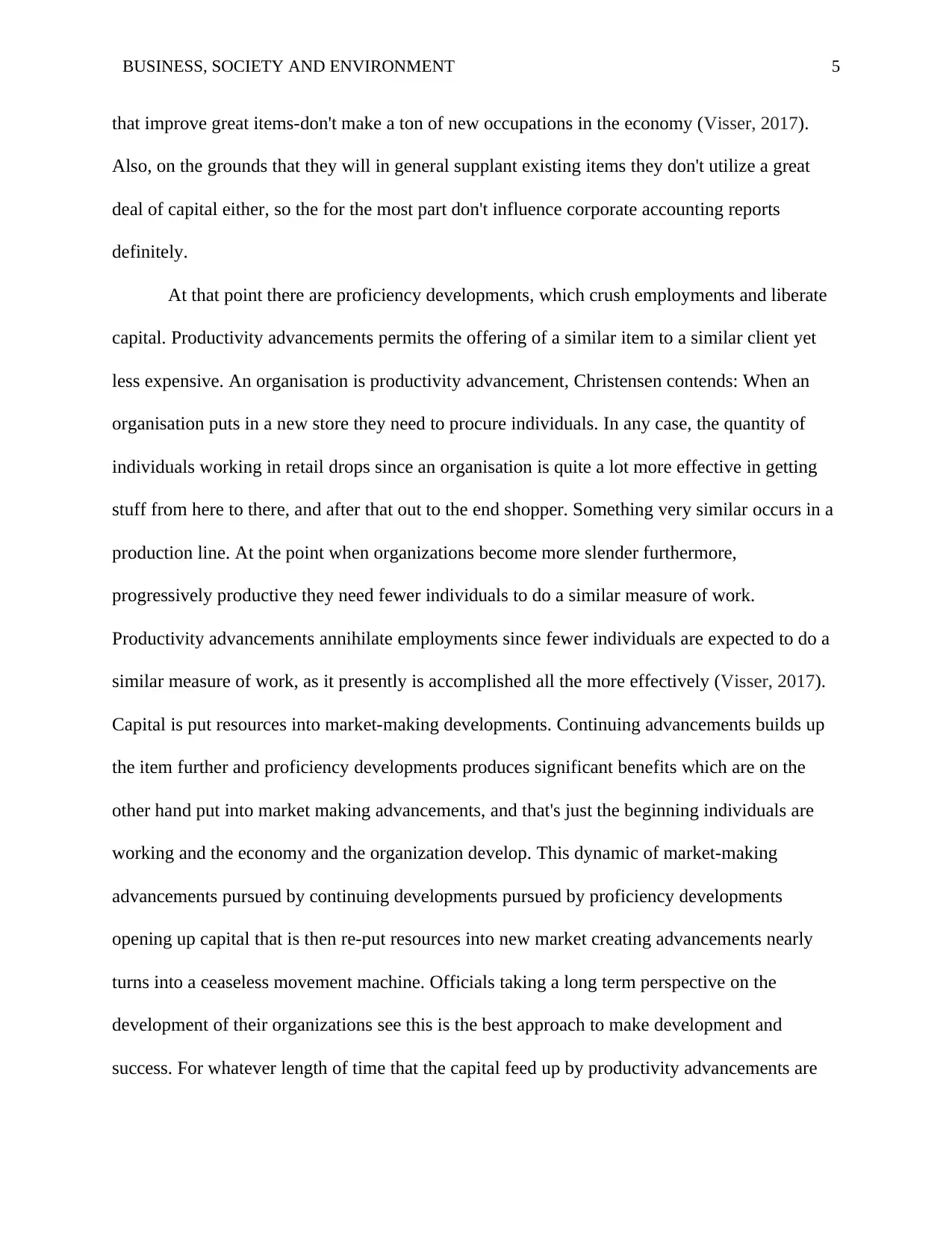
BUSINESS, SOCIETY AND ENVIRONMENT 5
that improve great items-don't make a ton of new occupations in the economy (Visser, 2017).
Also, on the grounds that they will in general supplant existing items they don't utilize a great
deal of capital either, so the for the most part don't influence corporate accounting reports
definitely.
At that point there are proficiency developments, which crush employments and liberate
capital. Productivity advancements permits the offering of a similar item to a similar client yet
less expensive. An organisation is productivity advancement, Christensen contends: When an
organisation puts in a new store they need to procure individuals. In any case, the quantity of
individuals working in retail drops since an organisation is quite a lot more effective in getting
stuff from here to there, and after that out to the end shopper. Something very similar occurs in a
production line. At the point when organizations become more slender furthermore,
progressively productive they need fewer individuals to do a similar measure of work.
Productivity advancements annihilate employments since fewer individuals are expected to do a
similar measure of work, as it presently is accomplished all the more effectively (Visser, 2017).
Capital is put resources into market-making developments. Continuing advancements builds up
the item further and proficiency developments produces significant benefits which are on the
other hand put into market making advancements, and that's just the beginning individuals are
working and the economy and the organization develop. This dynamic of market-making
advancements pursued by continuing developments pursued by proficiency developments
opening up capital that is then re-put resources into new market creating advancements nearly
turns into a ceaseless movement machine. Officials taking a long term perspective on the
development of their organizations see this is the best approach to make development and
success. For whatever length of time that the capital feed up by productivity advancements are
that improve great items-don't make a ton of new occupations in the economy (Visser, 2017).
Also, on the grounds that they will in general supplant existing items they don't utilize a great
deal of capital either, so the for the most part don't influence corporate accounting reports
definitely.
At that point there are proficiency developments, which crush employments and liberate
capital. Productivity advancements permits the offering of a similar item to a similar client yet
less expensive. An organisation is productivity advancement, Christensen contends: When an
organisation puts in a new store they need to procure individuals. In any case, the quantity of
individuals working in retail drops since an organisation is quite a lot more effective in getting
stuff from here to there, and after that out to the end shopper. Something very similar occurs in a
production line. At the point when organizations become more slender furthermore,
progressively productive they need fewer individuals to do a similar measure of work.
Productivity advancements annihilate employments since fewer individuals are expected to do a
similar measure of work, as it presently is accomplished all the more effectively (Visser, 2017).
Capital is put resources into market-making developments. Continuing advancements builds up
the item further and proficiency developments produces significant benefits which are on the
other hand put into market making advancements, and that's just the beginning individuals are
working and the economy and the organization develop. This dynamic of market-making
advancements pursued by continuing developments pursued by proficiency developments
opening up capital that is then re-put resources into new market creating advancements nearly
turns into a ceaseless movement machine. Officials taking a long term perspective on the
development of their organizations see this is the best approach to make development and
success. For whatever length of time that the capital feed up by productivity advancements are
⊘ This is a preview!⊘
Do you want full access?
Subscribe today to unlock all pages.

Trusted by 1+ million students worldwide
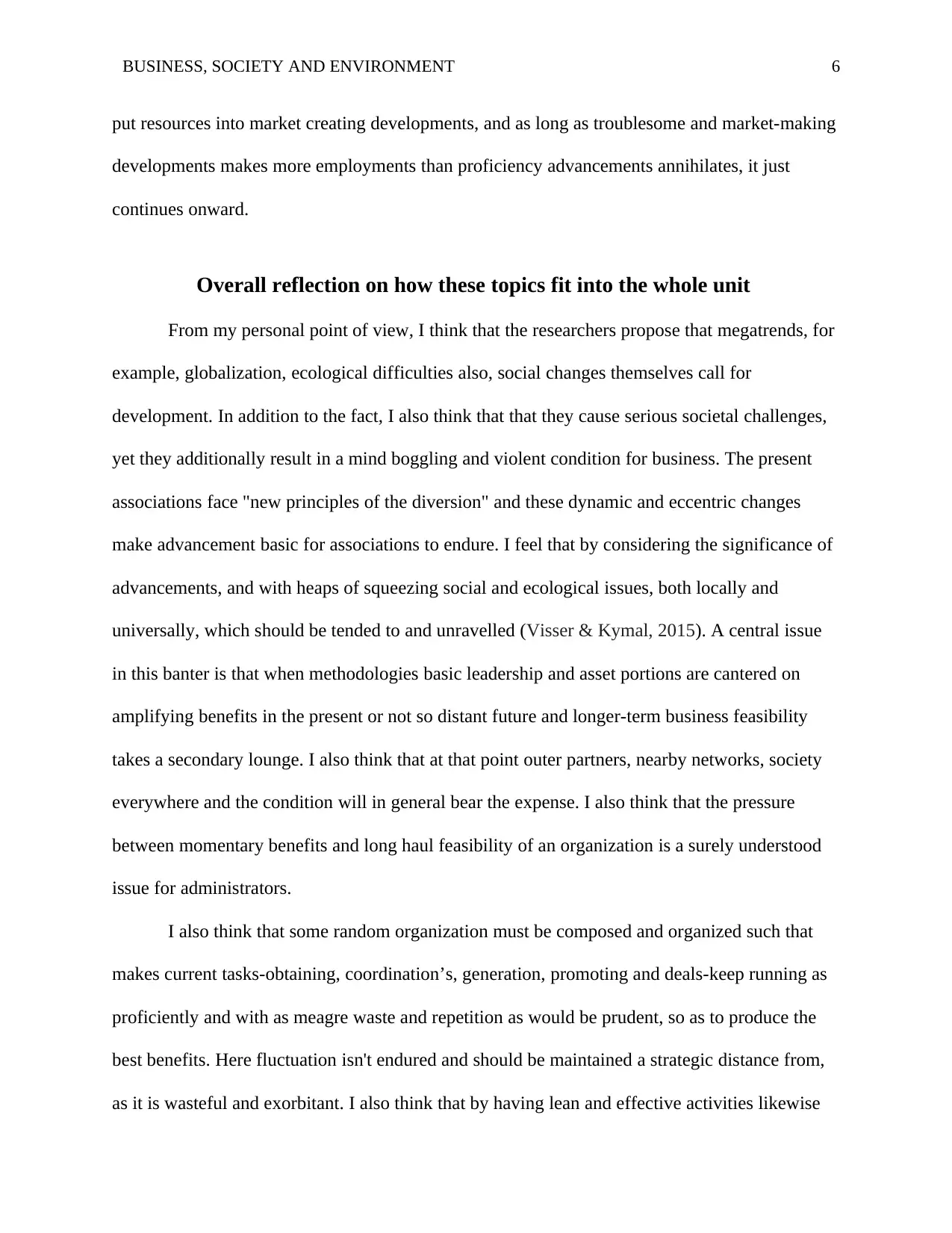
BUSINESS, SOCIETY AND ENVIRONMENT 6
put resources into market creating developments, and as long as troublesome and market-making
developments makes more employments than proficiency advancements annihilates, it just
continues onward.
Overall reflection on how these topics fit into the whole unit
From my personal point of view, I think that the researchers propose that megatrends, for
example, globalization, ecological difficulties also, social changes themselves call for
development. In addition to the fact, I also think that that they cause serious societal challenges,
yet they additionally result in a mind boggling and violent condition for business. The present
associations face "new principles of the diversion" and these dynamic and eccentric changes
make advancement basic for associations to endure. I feel that by considering the significance of
advancements, and with heaps of squeezing social and ecological issues, both locally and
universally, which should be tended to and unravelled (Visser & Kymal, 2015). A central issue
in this banter is that when methodologies basic leadership and asset portions are cantered on
amplifying benefits in the present or not so distant future and longer-term business feasibility
takes a secondary lounge. I also think that at that point outer partners, nearby networks, society
everywhere and the condition will in general bear the expense. I also think that the pressure
between momentary benefits and long haul feasibility of an organization is a surely understood
issue for administrators.
I also think that some random organization must be composed and organized such that
makes current tasks-obtaining, coordination’s, generation, promoting and deals-keep running as
proficiently and with as meagre waste and repetition as would be prudent, so as to produce the
best benefits. Here fluctuation isn't endured and should be maintained a strategic distance from,
as it is wasteful and exorbitant. I also think that by having lean and effective activities likewise
put resources into market creating developments, and as long as troublesome and market-making
developments makes more employments than proficiency advancements annihilates, it just
continues onward.
Overall reflection on how these topics fit into the whole unit
From my personal point of view, I think that the researchers propose that megatrends, for
example, globalization, ecological difficulties also, social changes themselves call for
development. In addition to the fact, I also think that that they cause serious societal challenges,
yet they additionally result in a mind boggling and violent condition for business. The present
associations face "new principles of the diversion" and these dynamic and eccentric changes
make advancement basic for associations to endure. I feel that by considering the significance of
advancements, and with heaps of squeezing social and ecological issues, both locally and
universally, which should be tended to and unravelled (Visser & Kymal, 2015). A central issue
in this banter is that when methodologies basic leadership and asset portions are cantered on
amplifying benefits in the present or not so distant future and longer-term business feasibility
takes a secondary lounge. I also think that at that point outer partners, nearby networks, society
everywhere and the condition will in general bear the expense. I also think that the pressure
between momentary benefits and long haul feasibility of an organization is a surely understood
issue for administrators.
I also think that some random organization must be composed and organized such that
makes current tasks-obtaining, coordination’s, generation, promoting and deals-keep running as
proficiently and with as meagre waste and repetition as would be prudent, so as to produce the
best benefits. Here fluctuation isn't endured and should be maintained a strategic distance from,
as it is wasteful and exorbitant. I also think that by having lean and effective activities likewise
Paraphrase This Document
Need a fresh take? Get an instant paraphrase of this document with our AI Paraphraser
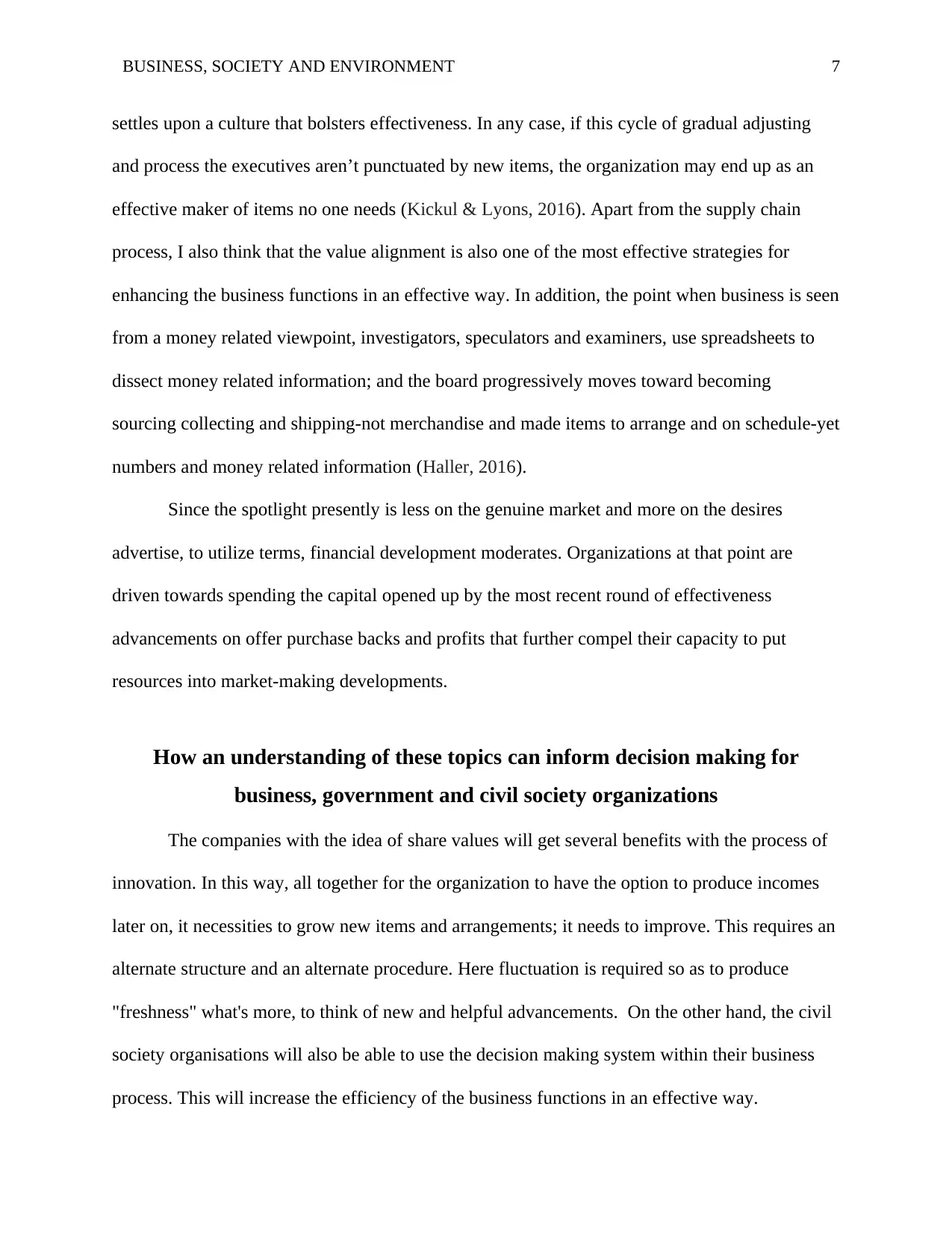
BUSINESS, SOCIETY AND ENVIRONMENT 7
settles upon a culture that bolsters effectiveness. In any case, if this cycle of gradual adjusting
and process the executives aren’t punctuated by new items, the organization may end up as an
effective maker of items no one needs (Kickul & Lyons, 2016). Apart from the supply chain
process, I also think that the value alignment is also one of the most effective strategies for
enhancing the business functions in an effective way. In addition, the point when business is seen
from a money related viewpoint, investigators, speculators and examiners, use spreadsheets to
dissect money related information; and the board progressively moves toward becoming
sourcing collecting and shipping-not merchandise and made items to arrange and on schedule-yet
numbers and money related information (Haller, 2016).
Since the spotlight presently is less on the genuine market and more on the desires
advertise, to utilize terms, financial development moderates. Organizations at that point are
driven towards spending the capital opened up by the most recent round of effectiveness
advancements on offer purchase backs and profits that further compel their capacity to put
resources into market-making developments.
How an understanding of these topics can inform decision making for
business, government and civil society organizations
The companies with the idea of share values will get several benefits with the process of
innovation. In this way, all together for the organization to have the option to produce incomes
later on, it necessities to grow new items and arrangements; it needs to improve. This requires an
alternate structure and an alternate procedure. Here fluctuation is required so as to produce
"freshness" what's more, to think of new and helpful advancements. On the other hand, the civil
society organisations will also be able to use the decision making system within their business
process. This will increase the efficiency of the business functions in an effective way.
settles upon a culture that bolsters effectiveness. In any case, if this cycle of gradual adjusting
and process the executives aren’t punctuated by new items, the organization may end up as an
effective maker of items no one needs (Kickul & Lyons, 2016). Apart from the supply chain
process, I also think that the value alignment is also one of the most effective strategies for
enhancing the business functions in an effective way. In addition, the point when business is seen
from a money related viewpoint, investigators, speculators and examiners, use spreadsheets to
dissect money related information; and the board progressively moves toward becoming
sourcing collecting and shipping-not merchandise and made items to arrange and on schedule-yet
numbers and money related information (Haller, 2016).
Since the spotlight presently is less on the genuine market and more on the desires
advertise, to utilize terms, financial development moderates. Organizations at that point are
driven towards spending the capital opened up by the most recent round of effectiveness
advancements on offer purchase backs and profits that further compel their capacity to put
resources into market-making developments.
How an understanding of these topics can inform decision making for
business, government and civil society organizations
The companies with the idea of share values will get several benefits with the process of
innovation. In this way, all together for the organization to have the option to produce incomes
later on, it necessities to grow new items and arrangements; it needs to improve. This requires an
alternate structure and an alternate procedure. Here fluctuation is required so as to produce
"freshness" what's more, to think of new and helpful advancements. On the other hand, the civil
society organisations will also be able to use the decision making system within their business
process. This will increase the efficiency of the business functions in an effective way.
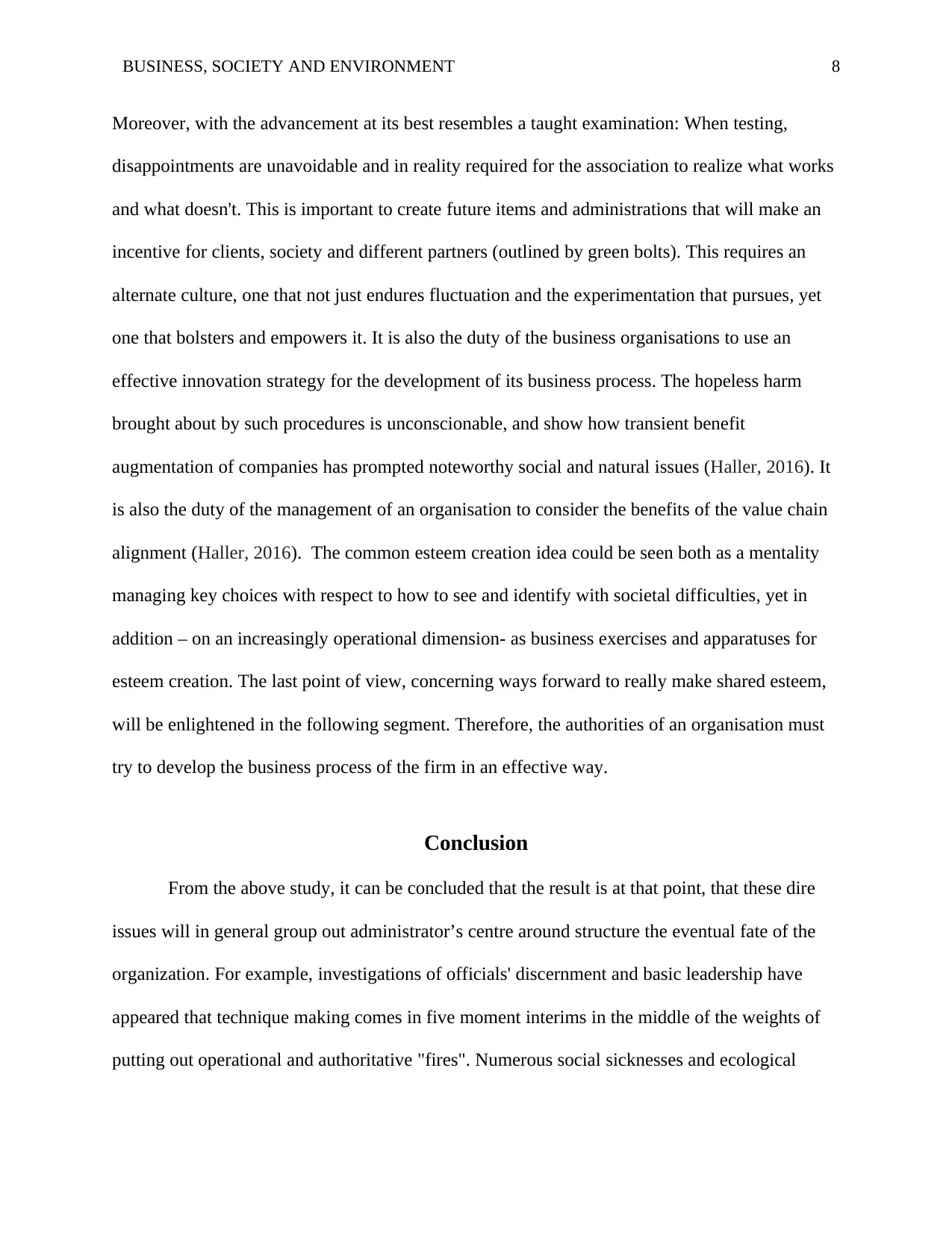
BUSINESS, SOCIETY AND ENVIRONMENT 8
Moreover, with the advancement at its best resembles a taught examination: When testing,
disappointments are unavoidable and in reality required for the association to realize what works
and what doesn't. This is important to create future items and administrations that will make an
incentive for clients, society and different partners (outlined by green bolts). This requires an
alternate culture, one that not just endures fluctuation and the experimentation that pursues, yet
one that bolsters and empowers it. It is also the duty of the business organisations to use an
effective innovation strategy for the development of its business process. The hopeless harm
brought about by such procedures is unconscionable, and show how transient benefit
augmentation of companies has prompted noteworthy social and natural issues (Haller, 2016). It
is also the duty of the management of an organisation to consider the benefits of the value chain
alignment (Haller, 2016). The common esteem creation idea could be seen both as a mentality
managing key choices with respect to how to see and identify with societal difficulties, yet in
addition – on an increasingly operational dimension- as business exercises and apparatuses for
esteem creation. The last point of view, concerning ways forward to really make shared esteem,
will be enlightened in the following segment. Therefore, the authorities of an organisation must
try to develop the business process of the firm in an effective way.
Conclusion
From the above study, it can be concluded that the result is at that point, that these dire
issues will in general group out administrator’s centre around structure the eventual fate of the
organization. For example, investigations of officials' discernment and basic leadership have
appeared that technique making comes in five moment interims in the middle of the weights of
putting out operational and authoritative "fires". Numerous social sicknesses and ecological
Moreover, with the advancement at its best resembles a taught examination: When testing,
disappointments are unavoidable and in reality required for the association to realize what works
and what doesn't. This is important to create future items and administrations that will make an
incentive for clients, society and different partners (outlined by green bolts). This requires an
alternate culture, one that not just endures fluctuation and the experimentation that pursues, yet
one that bolsters and empowers it. It is also the duty of the business organisations to use an
effective innovation strategy for the development of its business process. The hopeless harm
brought about by such procedures is unconscionable, and show how transient benefit
augmentation of companies has prompted noteworthy social and natural issues (Haller, 2016). It
is also the duty of the management of an organisation to consider the benefits of the value chain
alignment (Haller, 2016). The common esteem creation idea could be seen both as a mentality
managing key choices with respect to how to see and identify with societal difficulties, yet in
addition – on an increasingly operational dimension- as business exercises and apparatuses for
esteem creation. The last point of view, concerning ways forward to really make shared esteem,
will be enlightened in the following segment. Therefore, the authorities of an organisation must
try to develop the business process of the firm in an effective way.
Conclusion
From the above study, it can be concluded that the result is at that point, that these dire
issues will in general group out administrator’s centre around structure the eventual fate of the
organization. For example, investigations of officials' discernment and basic leadership have
appeared that technique making comes in five moment interims in the middle of the weights of
putting out operational and authoritative "fires". Numerous social sicknesses and ecological
⊘ This is a preview!⊘
Do you want full access?
Subscribe today to unlock all pages.

Trusted by 1+ million students worldwide

BUSINESS, SOCIETY AND ENVIRONMENT 9
issues have been brought about by organizations looking to expand transient benefits, while
obstinately overlooking the long haul impacts of their technique.
issues have been brought about by organizations looking to expand transient benefits, while
obstinately overlooking the long haul impacts of their technique.
Paraphrase This Document
Need a fresh take? Get an instant paraphrase of this document with our AI Paraphraser
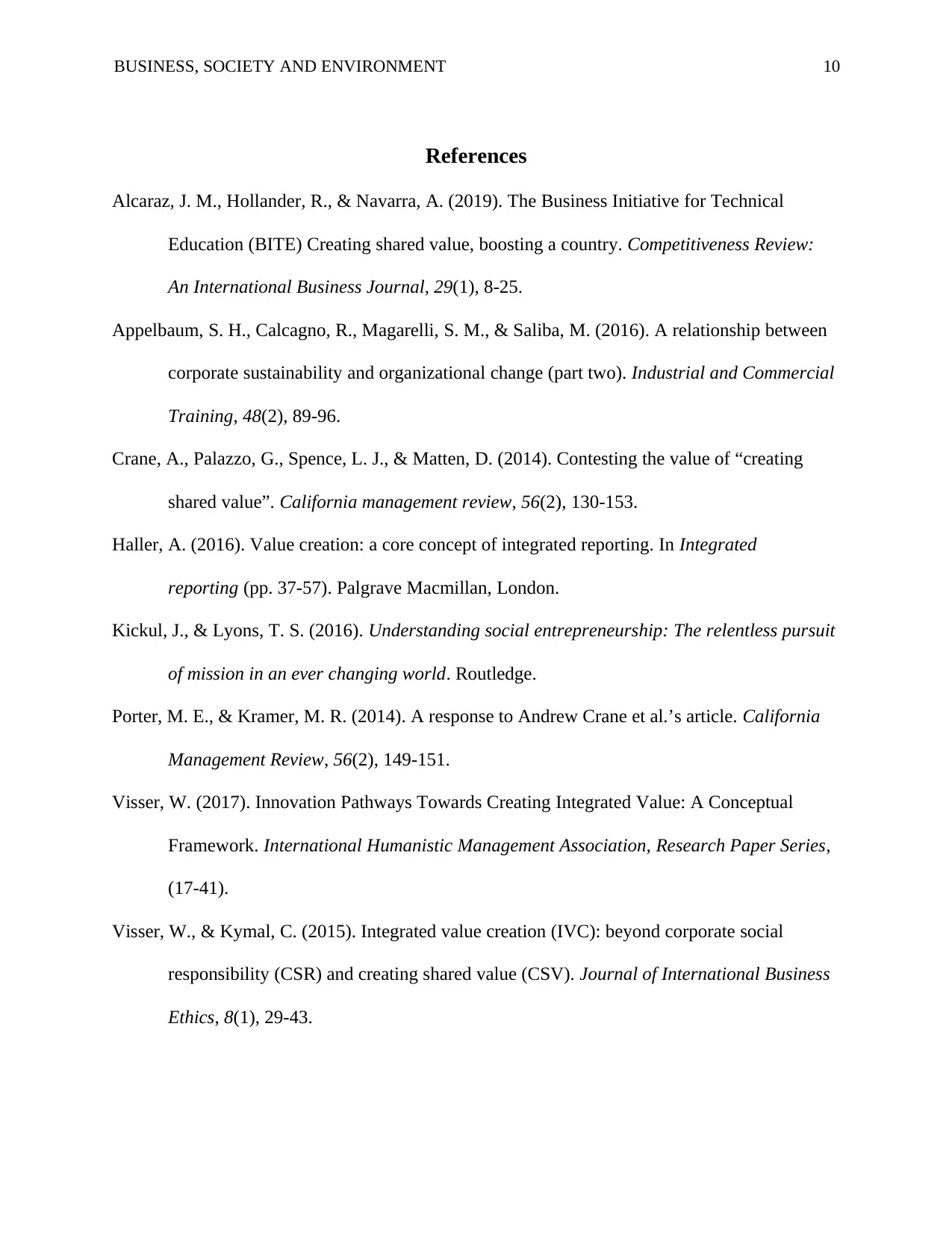
BUSINESS, SOCIETY AND ENVIRONMENT 10
References
Alcaraz, J. M., Hollander, R., & Navarra, A. (2019). The Business Initiative for Technical
Education (BITE) Creating shared value, boosting a country. Competitiveness Review:
An International Business Journal, 29(1), 8-25.
Appelbaum, S. H., Calcagno, R., Magarelli, S. M., & Saliba, M. (2016). A relationship between
corporate sustainability and organizational change (part two). Industrial and Commercial
Training, 48(2), 89-96.
Crane, A., Palazzo, G., Spence, L. J., & Matten, D. (2014). Contesting the value of “creating
shared value”. California management review, 56(2), 130-153.
Haller, A. (2016). Value creation: a core concept of integrated reporting. In Integrated
reporting (pp. 37-57). Palgrave Macmillan, London.
Kickul, J., & Lyons, T. S. (2016). Understanding social entrepreneurship: The relentless pursuit
of mission in an ever changing world. Routledge.
Porter, M. E., & Kramer, M. R. (2014). A response to Andrew Crane et al.’s article. California
Management Review, 56(2), 149-151.
Visser, W. (2017). Innovation Pathways Towards Creating Integrated Value: A Conceptual
Framework. International Humanistic Management Association, Research Paper Series,
(17-41).
Visser, W., & Kymal, C. (2015). Integrated value creation (IVC): beyond corporate social
responsibility (CSR) and creating shared value (CSV). Journal of International Business
Ethics, 8(1), 29-43.
References
Alcaraz, J. M., Hollander, R., & Navarra, A. (2019). The Business Initiative for Technical
Education (BITE) Creating shared value, boosting a country. Competitiveness Review:
An International Business Journal, 29(1), 8-25.
Appelbaum, S. H., Calcagno, R., Magarelli, S. M., & Saliba, M. (2016). A relationship between
corporate sustainability and organizational change (part two). Industrial and Commercial
Training, 48(2), 89-96.
Crane, A., Palazzo, G., Spence, L. J., & Matten, D. (2014). Contesting the value of “creating
shared value”. California management review, 56(2), 130-153.
Haller, A. (2016). Value creation: a core concept of integrated reporting. In Integrated
reporting (pp. 37-57). Palgrave Macmillan, London.
Kickul, J., & Lyons, T. S. (2016). Understanding social entrepreneurship: The relentless pursuit
of mission in an ever changing world. Routledge.
Porter, M. E., & Kramer, M. R. (2014). A response to Andrew Crane et al.’s article. California
Management Review, 56(2), 149-151.
Visser, W. (2017). Innovation Pathways Towards Creating Integrated Value: A Conceptual
Framework. International Humanistic Management Association, Research Paper Series,
(17-41).
Visser, W., & Kymal, C. (2015). Integrated value creation (IVC): beyond corporate social
responsibility (CSR) and creating shared value (CSV). Journal of International Business
Ethics, 8(1), 29-43.
1 out of 11
Your All-in-One AI-Powered Toolkit for Academic Success.
+13062052269
info@desklib.com
Available 24*7 on WhatsApp / Email
![[object Object]](/_next/static/media/star-bottom.7253800d.svg)
Unlock your academic potential
Copyright © 2020–2025 A2Z Services. All Rights Reserved. Developed and managed by ZUCOL.

